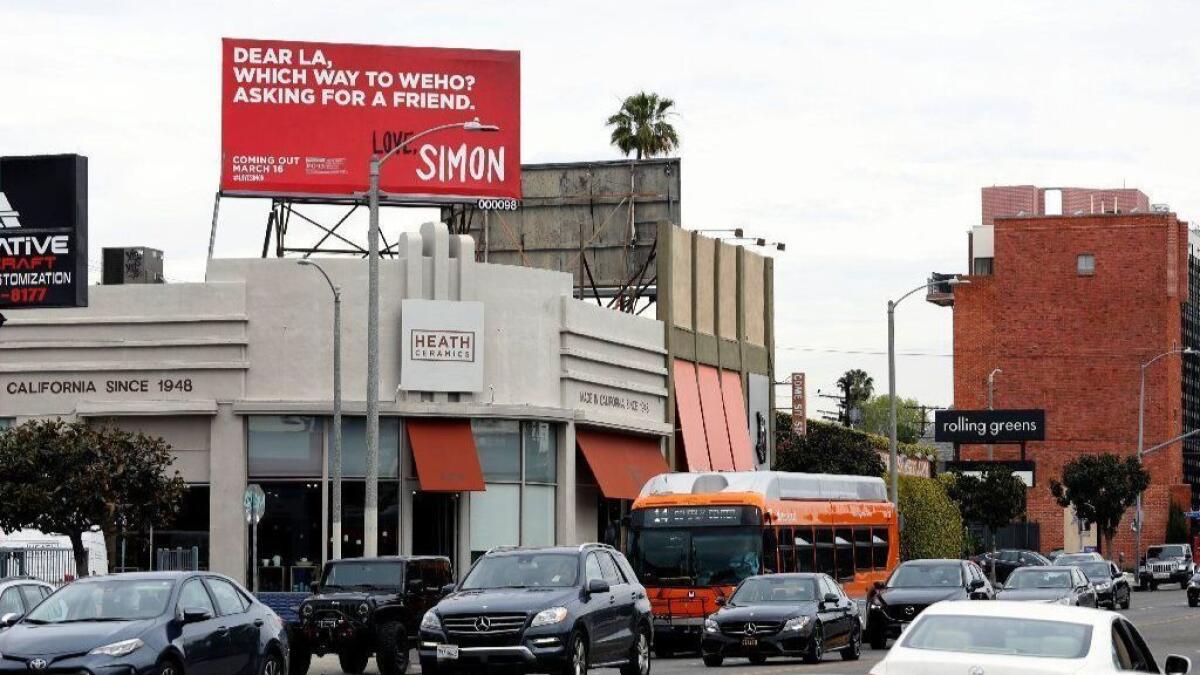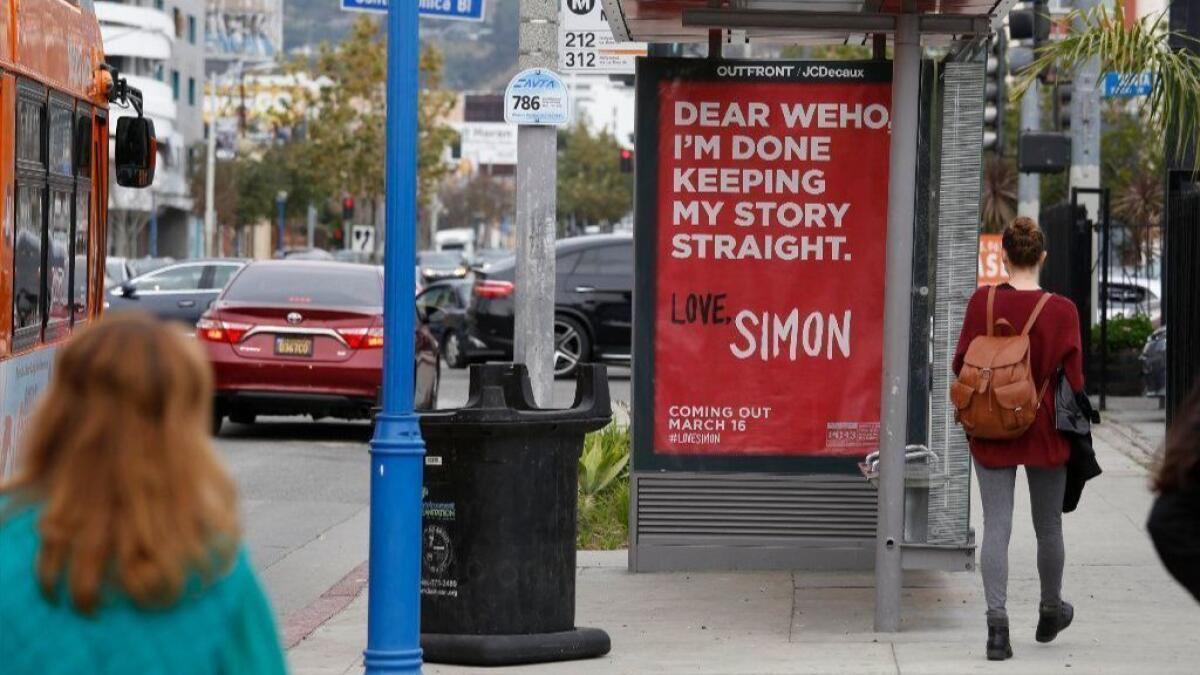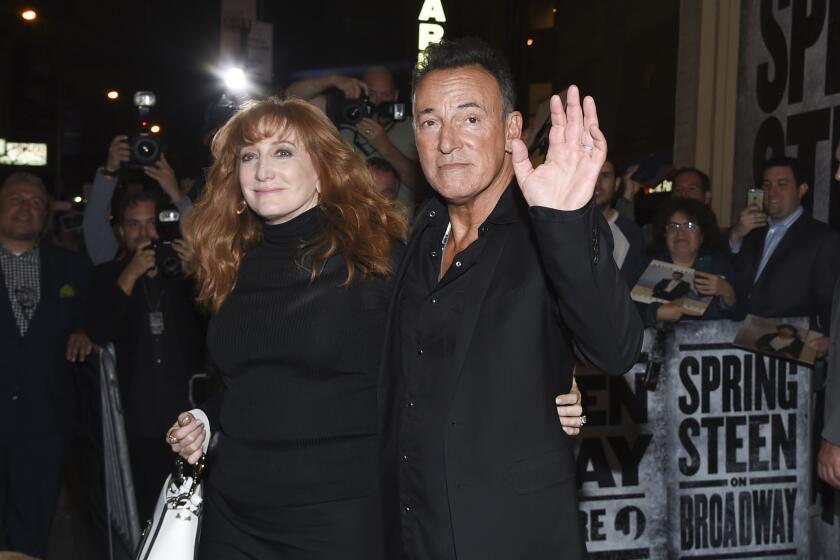Analysis: Inside Fox’s strategy to market ‘Love, Simon,’ the first film of its kind from a major studio

Perched above Beverly Boulevard near Fairfax Avenue, a cherry red billboard commands attention. In chunky white letters, a message is written to the city.
“Dear LA,” it reads, “Which way to WeHo? Asking for a friend.”
It’s signed, “Love, Simon.”
To most, the advertisement for 20th Century Fox’s latest film might not make any sense. That is until they discover that “Love, Simon” is a coming-out story. And then the unique cheekiness of the billboard becomes all the more intriguing, especially because a film in the studio system has never centered on a gay teen in this way.
The fact that Fox isn’t ignoring the picture’s queer identity is notable, if not historic, in its own right.
“The brilliance of the marketing for ‘Love, Simon’ lies in its honesty and in not shying away from the fact that the film is a gay teen romantic comedy,” said Paul Dergarabedian, senior media analyst for online measurement company ComScore. “While many films that have gay themes or a LGBTQ subtext often hide those elements in order to obscure the true message of the movie in order to make the film more ‘commercial’ or ‘mainstream,’ this film is rightly and innovatively celebrating and embracing its themes and point of view.”
I think people are used to any kind of LGBTQ love story being undermined.
— Becky Albertalli, author of “Simon vs. the Homo Sapiens Agenda”
“Love, Simon” follows 17-year-old Simon (played by “Jurassic World” and “Everything, Everything” heartthrob Nick Robinson), who has yet to tell his family or friends that he’s gay. His only confidant is an anonymous classmate with whom he trades emails and whom he soon realizes he’s in love with. When another classmate discovers the emails, Simon finds himself threatened with being outed to the entire school, something for which he’s not ready.
The coming-of-age tale, adapted from Becky Albertalli’s young adult novel “Simon vs. the Homo Sapiens Agenda” and directed by Greg Berlanti, is made in the spirit of the beloved teen films of John Hughes. It boasts a stellar ensemble of young actors, including Alexandra Shipp, Jorge Lendeborg Jr., Logan Miller, Keiynan Lonsdale and “13 Reasons Why” star Katherine Langford.
Fox is adept at marketing films of all genres, and Pam Levine, president of worldwide theatrical marketing, noted that “there’s not really a typical approach” that the studio takes.
“For marketing to work today, it has to be unique and customized to the film,” she said. “I think the audience has gotten really desensitized and bored with the playbook, so it is always about how do you stand out and sell the unique experience that the film delivers.”
When the marketing team first screened the film, “we fell in love,” Levine said.
“It really became a passion project for us in the sense that the film is so great and special and we felt deserved to be seen and embraced by a really broad audience. We challenged ourselves with, ‘How do we come up with a campaign that aspires to be as special as the film?’”
Long before “Love, Simon” went into production, fans of the source material were vocal about potential erasure of the story’s central queer theme.

“My readers were concerned when they heard the book was optioned,” said Abertalli, whose next book, “Leah on the Offbeat,” out April 24, is a sequel to “ Simon vs. the Homo Sapiens Agenda.” “I think people are used to any kind of LGBTQ love story being undermined.”
The fact that Fox chose to lean into the film’s identity is a step in the right direction as the industry continues diversifying its stories and the people responsible for telling them.
Levine and her team settled on a text-based “Dear [blank]” campaign, pulling in a narrative device from the film with customized billboard and bus stop promos specific to different film markets.
A second Los Angeles area advertisement, for example, reads: “Dear WeHo, I’m done keeping my story straight.” In New York, signs proclaim, “If I can come out here, I can come out anywhere.” Ads in the nation’s capital say, “Dear DC, You seem confused. Good thing I’m not.”
Other cities with tailored messages include Chicago, Philadelphia, San Francisco, San Diego, Boston and Dallas.
Fox also created a postcard generator that allows users to create their own “Dear [blank]” graphics. The film’s official Twitter account used it to send words of encouragement to openly gay Olympians Gus Kenworthy and Adam Rippon.
Because filmmaking — particularly filmmaking at a major Hollywood studio — is a business, the marketing team had to ensure that “Love, Simon” would be seen as not just a queer movie but accessible to non-LGBTQ people. That’s why they settled on “Everyone deserves a great first love story” as an overarching principle.
“I think this movie is both unique and universal,” said Kevin Campbell, Fox’s co-president of worldwide theatrical marketing. “You’re exploring the idea of first love through the eyes of a gay character, but, in fact, the thoughts and experiences [of that character are] relatable to everyone.”
Levine added: “We’re both embracing what is special about the film and noting that it’s not a indie film and is broadly accessible, so we wanted to sell it that way, but not shy away from what the film really is and how comfortable [the film] is with itself.”
Dergarabedian said he believes that the studio should be applauded for striking such a balance.
“You have to give Fox credit for taking this approach,” he said, “and like many films that have opened over the past year or more that have become hits while also sparking social change and honest discussion, ‘Love, Simon’ will likely reap the same benefits.”
Twitter: @TrevellAnderson
More to Read
Only good movies
Get the Indie Focus newsletter, Mark Olsen's weekly guide to the world of cinema.
You may occasionally receive promotional content from the Los Angeles Times.











